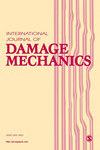Size effect modellings of axial compressive failure of RC columns at low temperatures
IF 3.9
2区 工程技术
Q2 MATERIALS SCIENCE, MULTIDISCIPLINARY
引用次数: 0
Abstract
This paper applied a thermal-mechanical sequential coupled mesoscopic simulation method to explore the axial compression performance and the corresponding size effect of Reinforced Concrete Columns confined by Stirrups (i.e., RCCS) at low temperatures, with considering the interaction between concrete meso-components and steel bars as well as the low-temperature effect of mechanical parameters. Based on the heat conduction analysis, the axial compression mechanical failure behavior of RCCS with four structural sizes (i.e., 267 × 267 × 801, 400 × 400 × 1200, 600 × 600 × 1800 and 800 × 800 × 2400 mm) and two stirrup ratios (i.e., 1.26% and 2.89%) at different temperatures (i.e., T = 20, −30, −60 and −90°C) was subsequently simulated. The effects of temperature, structural size and volume stirrup ratio on axial compression properties were quantitatively discussed. The results showed that the peak strength of RCCS increased with the decreasing temperature, and the smaller-sized RCCS showed a stronger effect of low-temperature enhancement. Both the residual strength and displacement ductility coefficient decreased with the decreasing temperature. The peak strength, residual strength and displacement ductility coefficient of RCCS decreased with the increasing structural size, showing obvious size effects. The size effect on peak strength increased with the decreasing temperature, (the maximum increase was nearly 140%), but the size effect on displacement ductility coefficient decreased (the maximum decrease was nearly 70%). The peak strength, residual strength and ductility were enhanced with the increasing volume stirrup ratio, which was helpful to reduce the influence of size effect. Finally, an improved size effect theoretical model was proposed, which can effectively predict the axial compressive strength of RCCS with different structural sizes and stirrup ratios at room and low temperatures. The present research results can provide reference for the large-scale engineering application of RCCS in low-temperature environments.低温条件下钢筋混凝土柱轴压破坏的尺寸效应模型
本文采用热力-力学顺序耦合中观模拟方法,在考虑混凝土中间构件与钢筋的相互作用以及力学参数的低温效应的前提下,探讨了箍筋约束钢筋混凝土柱(即 RCCS)在低温下的轴向压缩性能及相应的尺寸效应。基于热传导分析,随后模拟了四种结构尺寸(即 267 × 267 × 801、400 × 400 × 1200、600 × 600 × 1800 和 800 × 800 × 2400 毫米)和两种箍筋比(即 1.26% 和 2.89%)的 RCCS 在不同温度(即 T = 20、-30、-60 和 -90°C)下的轴向压缩力学破坏行为。定量讨论了温度、结构尺寸和体积箍筋比对轴向压缩性能的影响。结果表明,RCCS 的峰值强度随温度的降低而增加,尺寸较小的 RCCS 的低温增强效果更强。残余强度和位移延性系数均随温度的降低而降低。RCCS 的峰值强度、残余强度和位移延性系数均随结构尺寸的增大而降低,显示出明显的尺寸效应。对峰值强度的尺寸效应随温度的降低而增加(最大增幅接近 140%),但对位移延性系数的尺寸效应却降低了(最大降幅接近 70%)。随着体积箍筋比的增加,峰值强度、残余强度和延性都有所提高,这有助于降低尺寸效应的影响。最后,提出了一种改进的尺寸效应理论模型,该模型可有效预测不同结构尺寸和箍筋比的 RCCS 在室温和低温下的轴向抗压强度。本研究成果可为 RCCS 在低温环境下的大规模工程应用提供参考。
本文章由计算机程序翻译,如有差异,请以英文原文为准。
求助全文
约1分钟内获得全文
求助全文
来源期刊

International Journal of Damage Mechanics
工程技术-材料科学:综合
CiteScore
8.70
自引率
26.20%
发文量
48
审稿时长
5.4 months
期刊介绍:
Featuring original, peer-reviewed papers by leading specialists from around the world, the International Journal of Damage Mechanics covers new developments in the science and engineering of fracture and damage mechanics.
Devoted to the prompt publication of original papers reporting the results of experimental or theoretical work on any aspect of research in the mechanics of fracture and damage assessment, the journal provides an effective mechanism to disseminate information not only within the research community but also between the reseach laboratory and industrial design department.
The journal also promotes and contributes to development of the concept of damage mechanics. This journal is a member of the Committee on Publication Ethics (COPE).
 求助内容:
求助内容: 应助结果提醒方式:
应助结果提醒方式:


